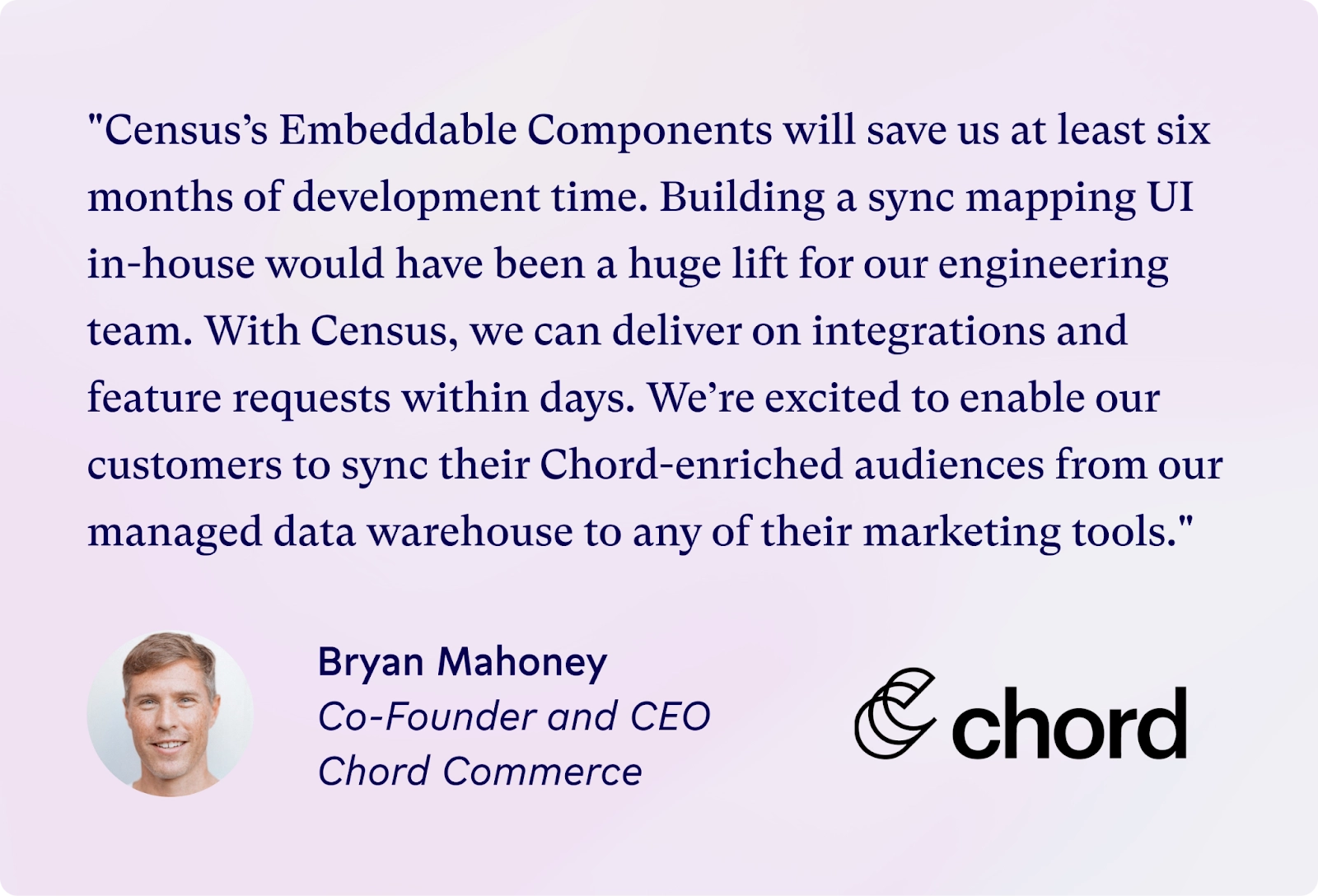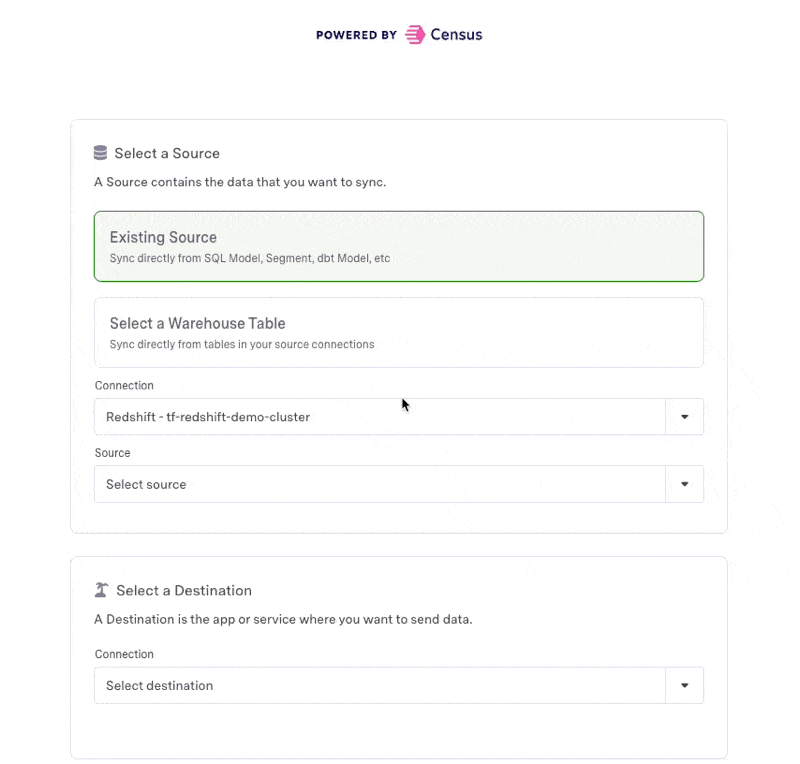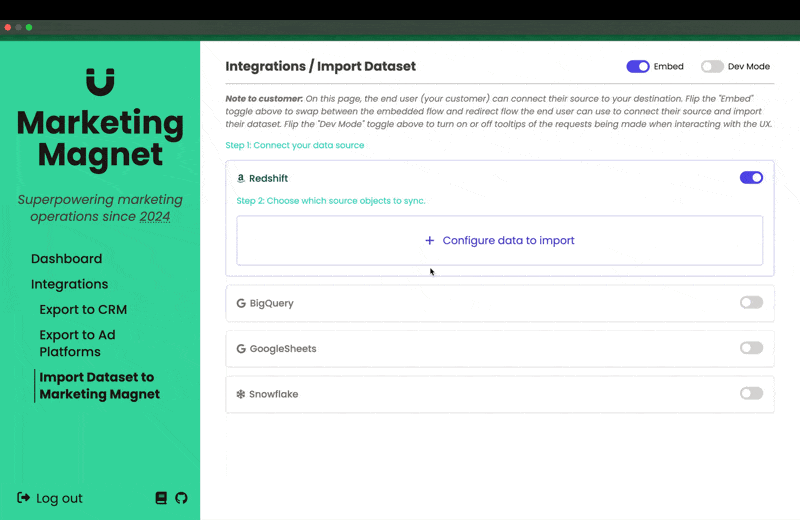Looking for a demo? Click here to jump to it on this page.
Traditionally, Reverse ETL helps internal business teams access insights in their cloud data warehouse to power smarter decisions and better customer experiences. Census’s best-in-class Reverse ETL platform syncs billions of records to GTM tools daily for companies like Activision, HubSpot, Canva, and Orangetheory Fitness.
However, we’ve always believed that the single source of truth shouldn’t be limited to internal business applications. It should be universally accessible, even across organizations, so businesses can share data externally with customers and partners.
That’s why we built Census Embedded, which enables companies to ingest data from their customers’ data warehouses or export data to their customers’ business applications, using our best-in-class Reverse ETL. Embedding our highly scalable and reliable data pipelines helps product and engineering teams rapidly ship and maintain customer-facing integrations natively within their own SaaS platform.

Introducing Embeddable Components, allowing any company to embed Reverse ETL Sync Creation into their application
Today, we’re excited to introduce Embeddable Components, which allow any Census customer to add the power of Census’s sync creation UI directly into their application.

Developing SaaS integrations is challenging because each integration has varying requirements– differences in required fields, nuanced sequences of API calls, many permutations of supported sync behaviors, and more. We’ve spent years perfecting a sync creation UI that accounts for all of the quirks inherent in 30+ source and 200+ destination APIs.

Embeddable Components free Census customers from handling all of these scenarios. Just drop in Census’s sync management flow, and we’ll take care of the rest.
Census Embedded helps SaaS companies fulfill customer needs, faster
Integrations are the backbone of modern SaaS. Every SaaS company regularly receives requests for integrations from prospects and customers, but building those integrations takes development resources away from improving the core product.
“Building a new Salesforce integration would take a minimum of 1, if not 2, full-time hires, and roughly 4 to 5 months of pure engineering time.”
— Ryan M, Engineering Manager at Metronome
Based on testimonials from our customers, we estimate that native integrations can take 5+ months to implement and cost over $100k and 10 hours per week to build and maintain. Additionally, complex destinations like Salesforce or Netsuite can require dedicated subject matter experts just to keep up with business objects and API requirements. Imagine repeating that effort for every SaaS integration a customer requests!
Census Embedded helps product and engineering teams save time and resources on developing native integrations, which in turn improves customer experiences and product agility. For example:
- Metronome, a billing platform, accelerated their Salesforce integration's time-to-market by 4 months and saved 2 full-time employees.
- Untitled, a Customer Data Platform, added new data activation integrations to their CDP that were used by over 50% of customers in the first 2 weeks.
- Labelbox, an AI/ML modeling platform, enabled rapid data onboarding via warehouse ingest integrations from 30+ sources, saving their customers tens of thousands of dollars of manual work.
But this isn’t a new problem. In the past, companies looking to embed pre-built integrations had another option: Embedded iPaaS. Let’s talk about why Embedded iPaaS isn’t the optimal solution for native integrations.
Embedded iPaaS falls short in data reliability and scalability
Many Integration Platform-as-a-Service (iPaaS) vendors — such as Zapier, Workato, Tray, and Boomi — also offer the option to embed their workflows into SaaS applications.
When we built Census Embedded, we drew on years of expertise in large-scale data integrations, 3rd party APIs, and maintaining a Reverse ETL platform with 99.9% uptime to build a best-in-class integration experience that goes beyond what solutions like Embedded iPaaS have provided in the past.
How Embedded iPaaS works
iPaaS tools connect one SaaS application to another by triggering an action based on an event. For example, a customer signing up for a newsletter in a Webflow form will immediately trigger a welcome email from HubSpot. These workflows are easy to set up, making Embedded iPaaS a popular choice for SaaS companies who want to quickly add native integrations.
“Before Census, I always had the problem of getting any sort of data into software tools. Classic ‘if this then that’ tools like Tray, Workato and Zapier are not geared well towards this type of data transfer. I was always looking for cheap tricks or hacks and they never fit the bill.”
—Benjamin Lewinsky, Director of Revenue Operations, Culture Amp
However, iPaaS’s trigger-based workflows are inherently flawed for multiple reasons:
- iPaaS is not eventually consistent — Maintaining data accuracy over time is impossible in iPaaS systems because when something inevitably goes wrong, iPaaS tools have very limited error recovery, monitoring, and debugging capabilities. iPaaS providers pass the responsibility of error handling onto their customers, meaning they often fail silently and are difficult to troubleshoot.
- iPaaS doesn’t scale for large data volumes — iPaaS systems were designed to trigger singular actions based on singular events (“if this, then that”), not to handle large-scale bulk updates that require syncing millions of records. Without the infrastructure to handle scale, these systems often fall short in processing speed, reliability, and pricing.
- iPaaS can’t handle batch data transformation — iPaaS’s trigger-based workflows are a type of event-driven architecture, meaning that each new record can only be appended to the end of a dataset. This makes it extremely difficult to fix or change historical data, resolve duplicates, and standardize data formats.
- iPaaS has high long-term maintenance costs — The combination of unreliable data syncing and poor observability means that over time, iPaaS tools cost more time and effort to maintain than a system that is purpose-built for large-scale data integration.

Over the years, Reverse ETL has proven to be the most reliable and scalable way to sync data. This reliability and scalability are doubly important when sending data to or from external organizations.
Embedded iPaaS can be suitable for small volumes of data or non-critical workflows, but companies looking for highly reliable and scalable SaaS integrations should consider Census Embedded.
How Census Embedded works
Census Embedded allows product and engineering teams to embed powerful Reverse ETL pipelines within their application. By providing the ability to securely collect credentials, configure syncs, and monitor and maintain them over time, Census Embedded accelerates integration time-to-value by months.
In an experience similar to Plaid, Census Connect Links securely collect credentials from external organizations.

Once credentials have been collected, customers can employ a variety of options to create a sync between themselves and the external organization.
Some customers have invited external organizations to use Census directly using our Custom Branding experience. Others have used our rich management API to bake Reverse ETL integrations directly into their SaaS product or service.
Today, we’ve added the ability to embed Census components directly into your application. Without leaving your app, your customers can both securely provide credentials and set up a sync.

Embedding Census into applications using the management API was already quick, generally taking customers about a week to implement. Now, it’s even easier. Customers can be up and running with embedded components in 1-2 days, making the deployment of powerful Reverse ETL pipelines faster than ever before.
Get Started
As part of our mission to make data activation automated and reliable, we’re proud to help every company and agency maximize the value of their customers’ data with Embedded Reverse ETL.
We can’t wait to see what the community builds on top of Census.
Ready to get started? Sign up for a free onboarding here. 🎉

















